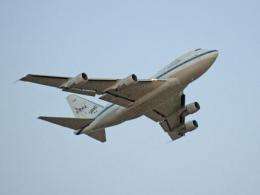Lowell Observatory astronomers chase Pluto's shadow across the Pacific ocean

(PhysOrg.com) -- On 23 June 2011, Pluto passed in front of a star and cast a small shadow on the Earth, and astronomers from Lowell Observatory were waiting. Four Lowell astronomers were among the scientists and crew who observed the rare occultation event from NASA's newest airborne observatory, SOFIA--the Stratospheric Observatory for Infrared Astronomy. SOFIA sports a 100-inch (2.5-meter) telescope aboard a modified 747SP aircraft, and can fly up to 45,000 ft. to get above most of the cloud cover and water vapor in the Earth's atmosphere.
The June 23rd Pluto occultation was observed using HIPO--the High-speed Imaging Photometer for Occultations. Built at Lowell Observatory, HIPO has dual high-speed cameras that record light at two wavelengths simultaneously. The instrument group at Lowell was involved in everything from design, fabrication, software, testing, and flight-readiness preparation. Lowell staff members Ted Dunham (HIPO Principal Investigator), Peter Collins, Tom Bida, and Brian Taylor all flew on SOFIA for the occultation flight.
Pluto holds onto a very thin atmosphere of nitrogen, methane, and a few other gases. Pluto's atmosphere was first measured directly by astronomers from MIT and Lowell Observatory in 1988 using the stellar occultation technique: monitoring the light from a star as Pluto and its atmosphere pass in front of it. The way in which the starlight dims lets astronomers determine the temperature and density of this tenuous atmosphere. In 1988, astronomers watched from a variety of telescopes in Australia and New Zealand, as well as from the Kuiper Airborne Observatory (KAO), a 36-inch telescope aboard a C-141A transport aircraft, while flying over the Pacific Ocean.
Pluto's tenuous atmosphere exists because of vapor-pressure equilibrium, where a small amount of gas resides above any solid ice surface. The atmosphere in this state is very sensitive to changes in surface temperature, and since 1989 Pluto has been receding from the Sun. Because the Sun is Pluto's prime source of heat, astronomers expect Pluto's surface to become colder and for its atmosphere to become less dense and to finally freeze out onto the surface. However, Pluto's atmosphere is instead becoming more dense, as has been shown through several occultation events observed since 1988. One goal of continued study is to understand the timescale of the global changes in Pluto's atmosphere; to this end, astronomers have been tracking Pluto occultations across the globe every year from March through October, during Pluto's observing season.
The ability to precisely position SOFIA within the shadow called for a massive prediction effort in the weeks before the event. Telescope time for astrometry (the measurement of precise positions of celestial objects) was secured at Lowell Observatory, the U.S. Naval Observatory--Flagstaff Station, and the Cerro Tololo Inter-American Observatory at La Serena, Chile. Lowell staff members Stephen Levine and Len Bright obtained the observations with the USNO and Lowell telescopes and immediately sent these data to MIT to be analyzed by the astrometry group there.
Amanda Bosh (MIT, visiting astronomer at Lowell Obs.) reports that astrometric images were appearing at MIT mere minutes after they were acquired. They were processed and Pluto's path toward the star was analyzed by Bosh and colleague Carlos Zuluaga (MIT) to determine where the shadow path would fall on the Earth. Researchers planned a last-minute flight path update, via Iridium satellite phone call between SOFIA and the researchers at MIT. The flight path was modified by about 125 miles; after the revision, SOFIA flew northwest for 30 minutes, capturing the occultation with both channels of HIPO as well as with the Fast Diagnostic Camera (Jurgen Wolf, Deutsches SOFIA Institut and SOFIA Science Center). The final update put SOFIA within about 65 miles of the exact center of the shadow.
Many ground-based observers also captured the event at locations in Hawaii, southern California, and Flagstaff, AZ. Other teams from the Southwest Research Institute (SwRI) and l'Observatoire de Paris were observing the same event throughout the Pacific basin; the SwRI team included Lowell astronomer Larry Wasserman who observed from the island nation of Nauru. Data analysis is underway and results will be presented at the Division for Planetary Sciences of the American Astronomical Society fall meeting in October 2011 in Nantes, France.
This Pluto occultation observation continues a long history of occultation science at Lowell Observatory that includes many astronomers, past and present, who have used the technique to study bodies as diverse as asteroids, planets, planetary rings, and stars. Key results include the discovery of the rings around Uranus in 1977, as well as Pluto's atmosphere in 1988.
Provided by Lowell Observatory




















